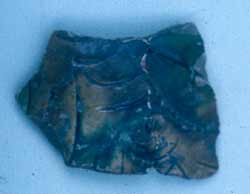Studying Pottery
The study of Mediaeval-Modern pottery on Crete (or in the Mediterranean more generally) has only come into its own in the last generation. Pottery of earlier epochs was studied as a matter of course, initially for aesthetic reasons (Classical Greek pottery), and then more broadly to obtain cultural and historical information. By the time Evans started to work at Knossos, it was already recognised that pottery was a key type of evidence for archaeologists (compare in general Unit 1 Session 4 Lesson 3). For the fully 'historic' Mediaeval-Modern period, however, scholars assumed that the core evidence would come from texts, with major buildings being mentioned from time to time; in their view, pottery by contrast could not produce useful information for this period.
In fact, as we have just seen (Unit 2 Session 3 Lesson 3), buildings can be illuminated when the associated pottery is studied. Moreover, the interest of pottery is not limited to buildings. For example, we know from texts that the Venetians were keen to control the export of cypress wood from Crete (cypress being a rare tree, particularly valuable for the construction of ships and large buildings). We know that cypress is a tree particularly common on Crete in the Samaria Gorge (in western Sphakia).
 Bodysherd of jug from Samaria. © Sphakia Survey |
The Sphakia Survey has found traces of timber mills all along the lower reaches of the Gorge, and in fact a Venetian map of western Crete by Coronelli (1692) (as we saw earlier featured in Unit 2 Session 1 Lesson 2) marks those mills. In exploring the village of Samaria in the heart of the Gorge we found part of a sixteenth century pot from Italy, probably from the region of Venice.
We shall return later (Unit 4 Session 3) to other Venetian pottery from Sphakia.